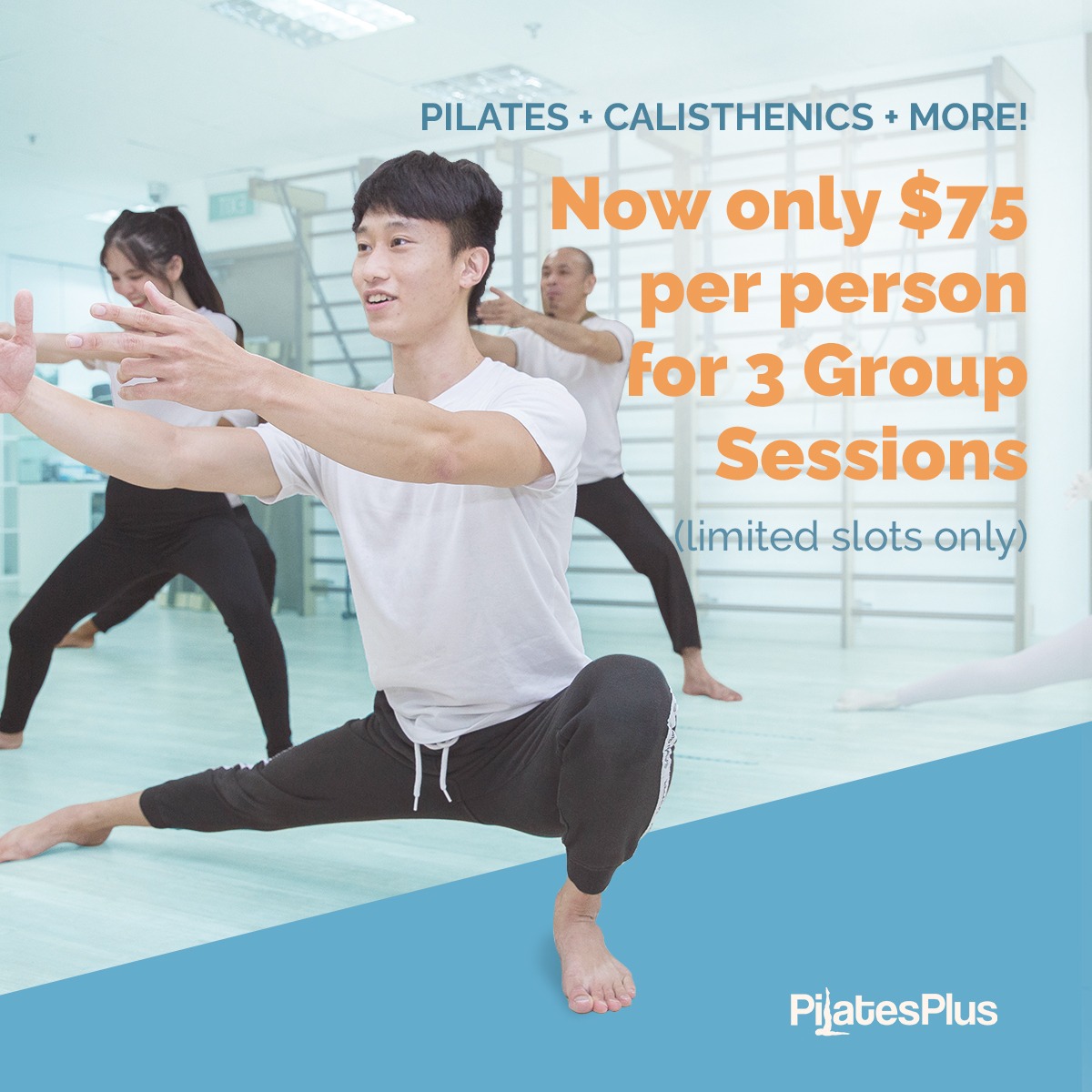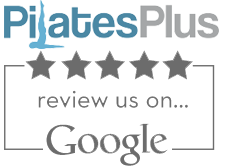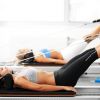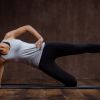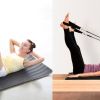PilatesPlus Blog
Home »
Can Beginners Do Reformer Pilates? Tips For First Timers!
Many of us think that Pilates Reformer is only for experienced Pilates practitioners. Unlike common fitness equipment, this unique-looking machine that you can only find in Pilates studios is not easy to figure out how to use, especially if you have no experience in Pilates exercises.
Beginners can do Reformer Pilates. Most Reformer exercises can be modified to suit a beginner level with the guide of a Pilates teacher. Make sure that you are attending a beginner-level session if you are planning to attend a Pilates Reformer group class, as there can be some advanced-level classes that will be too fast-paced for beginners.
The challenge with the Reformer Pilates is not about the intensity of the exercises done on it, nor do you need to be on an intermediate level in order to use it. In fact, I use the Reformer machine to do rehab with my clients and for complete beginners.
However, the complexity of using the Reformer is the main obstacle for first-time users on the machine. You will need guidance on the basic parts of the Reformer Pilates and the fundamental exercises that can be done on it. So the key ingredient is to attend a beginner’s class for the Reformer or get a good Pilates teacher to guide you with the movement.
Here are a few things that you need to know before attending your first Reformer Pilates Class!
Anti-slip socks are great for Reformer exercises
Reformer Pilates exercises require you to be in different positions where you need to push with your legs while lying down on the machine or stabilize yourself while you are standing on it. This can be slippery, especially if your feet tend to sweat or if you are wearing a normal pair of socks.
A pair of socks with a rubberized sole is a good solution for this. There are different brands available on the market, and some can be quite pricey for a pair of socks. They all serve the purpose of keeping you more stable during the exercise.
Let the teacher know that you’re a beginner
This is not needed if you are attending a beginner Reformer class, but there are some classes that are multi-level, and you need to inform the Pilates instructor that it is your first time doing the class so the teacher can keep an eye on you during the class.
Coming to the class 10 minutes earlier will also help so you can get familiar with the place and if allowed, you can go to the Reformer machine and get familiar with how it looks and feel. Some studios may allow you to just sit on it and do your own safe exploration before the class.
This is also a good time to talk to your Pilates teacher or to other attendees to make yourself comfortable.
It can be easier than Pilates mat class
You may think that Reformer exercises are a lot harder than Pilates mat exercises, but this is only partially true as some of the exercises are actually easier to do on the Pilates Reformer. Here is an article I wrote comparing Reformer and Mat exercises.
Because of the design of the Reformer, the intensity of the exercises can be adjusted with the springs. And at some times, the springs and straps of the machine can guide and assist you as you do your exercises which will make it easier compared to a mat workout where you have to rely on your strength to lift your own body.
Be familiar with how you breathe
Breathing is a big part of doing effective Pilates exercises and being familiar with your breath will help you go through the movements better. What I mean by being familiar with your breath is just by paying attention to how you breathe normally or breathe deeply.
We have been breathing since our first minute of existence on this planet, and most of the time, we take it for granted and never really pay attention to it. By just paying attention to your breathing before your first Pilates Reformer class will help you regulate it more so you won’t end up holding your breath when you are in challenging positions, or it will give you one less thing to think about during the exercises.
You can read my article about Pilates breathing to get more familiar with it.
Try to look at your posture in front of the mirror
One of the benefits that you can get from doing Reformer Pilates exercises is having a better posture. This Pilates equipment helps in realigning your body, correct muscle imbalances, and improve the symmetry of your movement.
But improving your posture is not a passive thing, and the correction is done before and after the exercise session. It is a consistent battle to correct the bad habits you have built from years of sitting in front of the computer.
It helps with the correction if you proactively work on your posture. One of the best ways to do this is to look at yourself in the mirror and be aware of your body’s alignment. The more aware you are of your posture, the easier it is for you to follow the minor corrections in the Reformer class.
When I start my Pilates class, there are 4 things that I would like my students to be aware of before we start the session. You can do them in front of the mirror, and use them as a guide in checking your posture at home.
- Feet – stand with your feet around hip-width apart and keep them as parallel as possible. You will notice that one foot is slightly turned out than the other.
- Mid-section area – try to pull your belly in just a little bit, so you are not fully relaxing the abdominal muscles. This will help you to stand up taller but make sure you don’t over contract the muscles that you will end up holding your breath. It has to be a sustainable effort for a long time.
- Shoulder area – Check if both your right and left shoulders are on the same height, in the same plane (not one shoulder more front than the other), and try to open your shoulders by squeezing your scapula backward.
- Stand as tall as you can – think of someone is measuring your height, and you want to make sure that you are taller than your last measurement. That means your effort will be reaching the top of your head upwards but not looking up. You will feel the work on both your abdominals and back muscles if you do this correctly.
I wrote an article about Pilates exercises for rounded posture. Read it as there are exercises that will be very helpful for you to correct your posture.
Here are more articles that will help you understand the Pilates Reformer better.
- Exercise positions you can do on the Reformer equipment.
- How do you breathe in Pilates
- Is Pilates Reformer harder than Pilates mat?
- How to get better with Reformer exercises?
- Reformer exercises that you can do at home using a towel and elastic bands.
6 Ways To Increase Intensity of Your Pilates Exercise!
Doing Pilates exercise can be deceivingly simple, especially when you are doing it only on the mat as it only involves your own body. You may think that using some small apparatus is the only way to make these exercises more challenging.
The Intensity of a Pilates exercise can be increased by going slower with the movement, doing pulses at the end of the range, focusing on contracting your muscles more, lesser rest between exercises, adjusting the angle of the legs or arms, and working on a proper technique.
You can either do one or combine a few ways to intensify your Pilates exercises. These techniques apply to most of the exercises whether you are using the Pilates equipment or mat.
- Slow down the movement
Decreasing the speed of your movement will increase the amount of time your muscles contract; thus, it will have to work more with the same number of repetitions. As a general rule, the bigger muscles will do the work to complete the task when you move faster. But when you do it slower, since the bigger muscles will fatigue faster, the body will recruit the smaller muscle groups to help you get through the movement.
This will make the exercise more challenging and complete as you will strengthen both bigger (fast-twitch) and smaller (slow-twitch) muscles.
Slowing down the speed of the movement can be applied to almost all Pilates movement.
- Moving small range movement or pulses
Another way to work harder is you find where the angle that is the most challenging and stay on that angle. You can either just hold the position or do very small 2 to 4 inches of pulsing movement.
This will make the exercise very challenging and effective in strengthening your full range.
A good example will be the Pilates Roll up; the most challenging angle of this exercise is when you are about to touch your lower back on the mat. Stay on that angle and do a small up and down movement without resting on the mat and without coming too high either.
You will feel a strong burn in your abdominal muscles even doing lesser repetitions of the same movement.
- Learn how to control the muscles
This is a little tricky one. Most beginners in Pilates practice will either find the exercises too challenging or too easy. One reason why most of them find it too easy is not knowing how to engage the correct muscles.
It is a good practice to learn how to engage the individual muscles of the exercise by touching them firmly or giving them a firm push so you will feel them contracting. The more you feel the muscles, the better you can control them when you do the movement.
I have realized with Pilates that the basic exercises have become harder for me as I practice throughout the years. This is because I have gotten better at engaging the muscles, that even doing spine twists in a standing position can cause my core muscles to cramp.
- Lesser rest time between exercises
This is easy to guess, but sometimes you might be taking breaks unknowingly as you are trying to work on the details of the individual exercises. As much as it is important to be precise with the movement, working continuously with very little rest in between will give you a different benefit from the workout.
Try to practice the individual exercises in a separate session and polish them well. When it’s time to work on the full routine, try to minimize stopping and correcting the movement and allow the exercises to flow from one movement to another.
- Adjusting the angle of your legs or arms will change the intensity of the exercises
Pilates exercises are mainly bodyweight exercises except when using the Pilates Reformer, where you can use the springs to add intensity to the workout.
The principle of adjusting the intensity in bodyweight training is all about leverages. This means that the further your extremities are from the center, the harder the exercise will be.
For example, when doing the hundreds, it will be easier if you keep your legs more vertical, and it will be at its hardest when you lower your legs straight close to the floor.
Another good example is when doing the Roll-up; if you keep your arms extended to the front, which is the normal way of doing it, it will be easy. Now, try to keep both hands on your chest, and rolling up will be a little harder. If it is still manageable for you, try placing both hands on your forehead or keeping your arms extended overhead just by the side of your ears.
- Work on proper technique
In Pilates exercise, the form not only keeps you safe, makes the exercise more effective, but it will also make it more intense. Keep on perfecting your technique with the individual movements, and you will realize that certain movements will become more intense.
This goes well when you are doing the exercise at a slower pace and trying to feel the right muscles needed to be engaged in the movement.
Is Pilates Reformer Harder Than Pilates Mat?!
Planning to attend your first Reformer Pilates class can be quite daunting. The machine doesn’t look like common fitness equipment. It has a moving carriage, straps attached to it, and uses springs as resistance. The moves you see on social media make you think that the Reformer exercises are only meant for advanced practitioners. And you may think that Pilates mat is your only option as a first-timer.
There are exercises on the Pilates Reformer that are easier than Pilates mat, and there are also more challenging exercises. The Reformer machine is designed so that the springs can either assist or challenge the actual movement.
Let me explain how the Reformer machine makes the exercises easier or harder than mat Pilates.
Pilates Mat and Reformer Comparison
| Pilates Mat | Pilates Reformer | |
| Movement Complexity | Less complex as you only have your body to deal with | More complex as it involves the equipment set up |
| Convenience | You can do it anywhere | You need a Pilates Studio to practice or buy your Reformer machine |
| Variety | Limited variety | More variety |
| Assistance | You have to rely on your own strength | The straps, the foot bar, and other parts of the machine can give you assistance to your exercises |
| Feedback and awareness | No feedback except the floor and mat | The setup of the Reformer is a good added feedback to increase your awareness with you the exercises. |
| Range of motion | Limited range depending on your mobility | Wider range because of the straps and elevated platform |
| Stability | Very stable | Harder when the carriage has very low spring support |
| Resistance | Depends on your body weight | It can be controlled by adjusting the springs |
| Easier to mount | Harder for older people and those with back and knee injuries. | Easier to mount |
| Intensity range from 1 to 10 (1 = easiest and 10 = hardest) | Between 3 to 8 intensity | From 1 to 10 intensity |
What is a Pilates Reformer?
Let me describe to you briefly what a Pilates Reformer is before we go on with the topic. This machine has the size smaller than a single bed with half of its length is covered by a moving carriage that can move horizontally. The springs are attached from the front of the frame to the front of the carriage, making it return to the front all the time.
The back of the carriage has a headrest that can be raised up and down, and it has a pair of shoulder pads. The carriage is connected to the back of the frame by a pair of straps looped in a pulley system. You can do a lot of things on the Reformer. Here is an article I wrote about the different positions you can be in on the machine.
What is Pilates Mat?
Pilates mat exercises are movements on the mat to work your whole body without using any equipment. Originally, there is a 34 exercise list that was written by Joseph Pilates in the early 1900s for the purpose of giving us a daily routine to move better as we age. It is very effective to strengthen your core, improve your flexibility and work on your breathing.
What makes the Pilates Mat harder than the Reformer exercises?
Relies on your relative strength to weight ratio
When doing the Pilates mat exercise, you will solely rely on your strength to move in certain positions when doing the exercises. That means if you carry extra kilos in your weight, it can be more challenging than someone lighter.
For example, doing bodyweight squats or heel raises can be more challenging if you are heavier. If you compare these with the same exercise done on the Reformer, the intensity can be adjusted by having lower or higher spring resistance.
Harder when you lack the flexibility
There are exercises on the Pilates mat that can be harder to hold if you lack flexibility. A good example of these are exercises that require you to hold either one or two legs up in the air like single-leg circles and double leg raises. When you do these movements on the Pilates Reformer, the exercises will be a lot easier. The straps will help you carry your legs, and will assist you to move your legs in different patterns that would be otherwise impossible or very challenging to do if you do it on the exercise mat.
What makes the Reformer exercises easier than Pilates Mat?
An elevated platform is easier to mount on
Aside from the adjustability of the springs and the assistance of the straps that the Pilates Reformer can do for your exercises, it is also easier to go onto the machine than on the floor. This is especially true if you have lower back pain or knee injury, as it will be challenging for you to go up and down from the floor.
Easier to establish alignment
The Pilates Reformer will also help you do your movement in better alignment. The straps, shoulder pads, and foot bar can give you feedback on making your movement more symmetrical. Thus, it is easier to do it correctly than doing it on the mat, where you have to rely fully on your awareness in space as you work through the exercises.
This is why Pilates Reformer is popular in Rehabilitation clinics.
If you want to try some exercises on the Reformer that you can do without the machine, I wrote an article about 12 Pilates Reformer exercises that you can do at home.
What makes the Reformer harder than Mat exercises?
More Resistance from springs
On the other hand, the Reformer machine can also be used to make the exercise more challenging. A simple way to make the exercise harder is to add more spring resistance. This will be true to arm exercises that will be significantly harder when you use heavier or more springs.
Unstable platform
The moving carriage will make the exercise more unstable; thus, it will require more strength, balance, and concentration to do it. These exercises are best done when you have more experience with the machine.
A bigger range of movement
Because of the setup of the Reformer exercises, you will be able to go bigger with your movement than what you can do on the mat. The elevated platform will allow you to move further down than where you are mounted and the moving carriage will get you into stretch positions that are very awkward to do on the mat. This makes the Reformer exercises more intense.
More movement complexity plus the features of the equipment
The Reformer exercises are also more complex in general. So a total beginner will have a hard time in terms of learning the exercises and at the same time getting to know the machine.
There are hundreds of Reformer exercises for you to learn, so it is harder to master them all compared to the original 34 mat sequence.
Conclusion
In summary, the Pilates mat exercises can be harder to start with regards to intensity, but it is simpler to learn as there are not as many variations compared to the Reformer exercises.
The Reformer exercises, on the other hand, can be a lot easier to start with but it is a little more complicated to learn as you have to learn to set up the machine. This will require you to have a guidance of a teacher to start with.
At the same time, Reformer exercises can be a lot more advance than the mat exercises.



